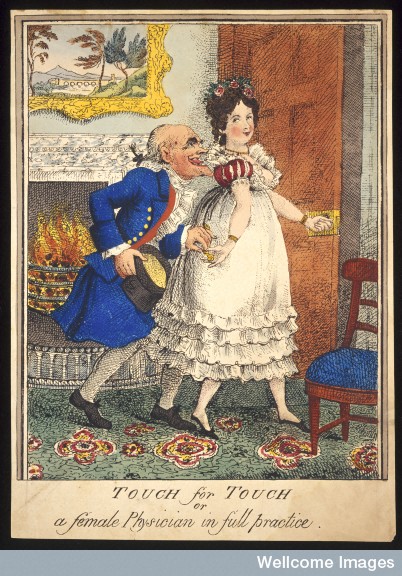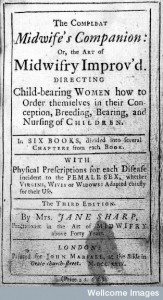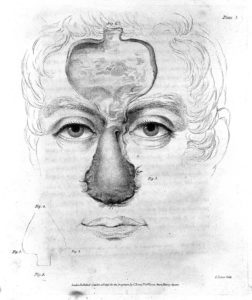
‘I began to perceive I was with Child’: Pregnancy and Prostitution.
Professor David Lodge famously wrote that ‘Literature is mostly about having sex and not much about having children. Life is the other way round’.1 This seems to be especially true of the erotic literature produced in Restoration England in which prostitute narratives are filled with sexual encounters but very few pregnancies. In the anonymous novel The London Jilt (1683),exotically subtitled, The Politick Whore Shewing the Artifices and Stratagems which the Ladies of Pleasure make use of for the Intreaguing and Decoying of Men, interwoven with Several Pleasant Stories of the Misses Ingenious Performances. The protagonist Cornelia has two pregnancies: one real and one feigned during the course of part one. This book was published at the height of what Roger

Credit: Wellcome Library, London.
Thompson has termed ‘the 1680s festival of filth’.2 Prostitute Cornelia, who narrates her own tale, tell us that she is most surprised to discover that she has fallen pregnant:
Tho that my Territory was so frequently cultivated by five Men; and by this Reason it seem’d there could not arise any Fruit, by Reason I figured to myself, that the too great abundance of Humidity would be capable of stifling it in its Birth. Nevertheless after having led this life six Months, I began to perceive I was with Child.3
The language used here of her womb as a territory which is ploughed mirrors the language in medical books which use a metaphor taken from Aristotle that the womb is a passive receptacle of the male seed, usually expressed as the ‘agent and patient’ model, or the womb as a field (the patient) and the male seed as the plough (or agent). Midwife Jane Sharp explains that ‘Man in the act of procreation is the agent and tiller and sower of the Ground, Woman is the Patient or Ground to be tilled, who brings Seed also as well as the Man to sow the ground with’.4 Sharp, of course, modifies the idea of passivity and merges her explanation with the Galenic two-seed model, which argued that both parties needed to emit seed at orgasm to produce a pregnancy. She goes on feistily to declare that ‘I am now to proceed to speak of this ground or Field which is the Womans womb, and the parts that serve to this work: we women have no more cause to be angry, or be ashamed of what Nature hath given us than men have, we cannot be without ours no more than they can want theirs’.5 Cornelia’s explanation for why she was surprised might seem odd to us, who might be inclined to think that having regular sex with five partners was an effective method of producing a pregnancy. However it accords  entirely with early modern humoral medical thinking. Midwife Jane Sharp explains that if the cervix is ‘too often and unreasonably opened by too frequent coition, or in over moist bodies, or by the whites, it makes women barren, and therefore Whores have seldom any Children’.6 As Cornelia intimates, too much sex means too much fluid in the womb, and so it was assumed to be too wet and slippery for a pregnancy to survive. As Sharp’s modifier makes clear this assumption is only partially reliable and the reason whores only ‘seldom’ conceive. Sharp repeats this assertion in her later section on infertility, ‘too frequent use makes the womb slippery, and therefore whores have but few children’.7
entirely with early modern humoral medical thinking. Midwife Jane Sharp explains that if the cervix is ‘too often and unreasonably opened by too frequent coition, or in over moist bodies, or by the whites, it makes women barren, and therefore Whores have seldom any Children’.6 As Cornelia intimates, too much sex means too much fluid in the womb, and so it was assumed to be too wet and slippery for a pregnancy to survive. As Sharp’s modifier makes clear this assumption is only partially reliable and the reason whores only ‘seldom’ conceive. Sharp repeats this assertion in her later section on infertility, ‘too frequent use makes the womb slippery, and therefore whores have but few children’.7
In common with most of these types of narratives, the child Cornelia is carrying, a girl, is later stillborn after a protracted labour lasting from Wednesday until Saturday. Cornelia is secretly delighted knowing that a child would seriously hinder her trade. Later in the story one of Cornelia’s paid clients announces that he would like a child with her. Cornelia considers that she is seriously unlikely to be able to conceive a second time since she now has fifteen regular lovers: ‘I knew very well that I should not easily be with Child as the first time (for now instead of having to do with only five, I had full three times as many daily Gallants, who lay with me in their Turns)’.8 Cornelia instead fakes a pregnancy to con an annuity from her lover. Her scheme is successful and she uses over-tightened corsets to push out her abdomen whenever the would-be father is in her company. However, she is betrayed by her disgruntled maid bringing the sham pregnancy to an end.
Apart from a brief mention of an ‘Artifice which has been found out to prevent a womans being with child’ which Thompson speculates is an allusion to the ‘dutch cap’ barrier method of contraception, referred to in relation to young married couples, not prostitutes, the reliance of the slipperiness of the whore’s womb seems to be the most usual guard against conception given in these narratives.9
___________________
1 David Lodge The British Museum Is Falling Down (1965), p. 56.
2 Roger Thompson, Unfit for Modest Ears (Basingstoke: Macmillan, 1979), p. 77.
3 Anon, The London Jilt (London: Henry Rhodes, 1683), p. 76.
4 Jane Sharp, The Midwives Book; or, the Whole art of Midwifry Discovered(London: Simon Miller, 1671), p. 34.
5 Midwives Book, p. 34
6 Midwives Book, p. 80.
7 Midwives Book, p. 180.
8 The London Jilt,p. 93.
9 Thompson’s deduction is founded in the description in the novel of the method as a great inconvenience to women’s pleasure since they experience the ‘agitation’ of coition but not the joy of ejaculation or ‘the shower’. The London Jilt, p. 80 and Unfit for Modest Ears, p. 78.
© Copyright Sara Read all rights reserved.


Wrong period, but you might be interested to know of my extensive collection of US artefacts and ephemera concerning pregnancy and morals from the era before the introduction of the Pill.
It consists of postcards, penny dreadfuls, posters, sex manuals, confessional autobigraphies (real and fake), swizzle sticks, ashtrays, mantelpiece figurines, and so on.
The themes are quite interesting. In the early 20th century, there is concern that white middle class women are not having enough children. “No Race Suicide Here” is the typical slogan, accompanying photos or cartoons of large families of black sharecroppers, Native American Indians, animals, etc. There are pictures of flatchested flappers and bluestockings desperately avoiding storks, and so on. Crude pro-natalism.
On the other hand, the next phase shows mockery of unplanned pregnancy, especially outside marriage. There are a lot of “shotgun wedding” cartoons. The largest number, however, show just a pregnant woman, often naked or dressed in rags. “Kilroy Was Here,” “Because of You,” “I Should Have Danced All Night.” These come in the form of bar paraphernalia and domestic mantelpiece statuettes of varying quality. I have some huge wooden statuettes from the Philippines, showing what appear to be African women, with “Because of You” carved in English or Tagalog on the pedestal. Souvenirs for servicemen, presumably. Cautionary tales, with greater or lesser degrees of good humour.
Everything changes with the Pill. Depictions of pregnancy, in these genres, become sentimental. Gentle pro-natalism.
Although they have disappeared from sight and memory, this was clearly a mass market group of products, shaping or expressing popular attitudes through media that have become invisible to the historian. The barroom objects — I have whole panels of plastic swizzle sticks, waiting to be detached — might perhaps be compared to the early modern broadsheet on the alehouse wall, which we assume was for public performance and discussion.
That is fascinating, we have been using an image of a woman pursued by the stork for our perceptions of pregnancy conference , its great to hear a little more about them.
I have dozens of different stork postcards. Let me know if you would like some scanned.
That collection sounds fascinating. Would love to see photos of it David.
I don’t have a scanner of my own. I’ll wander down the road and get it done, as soon as I can dig some out of the cabinets in the basement. I’ll try to give you a good set of storks and a selection of others.